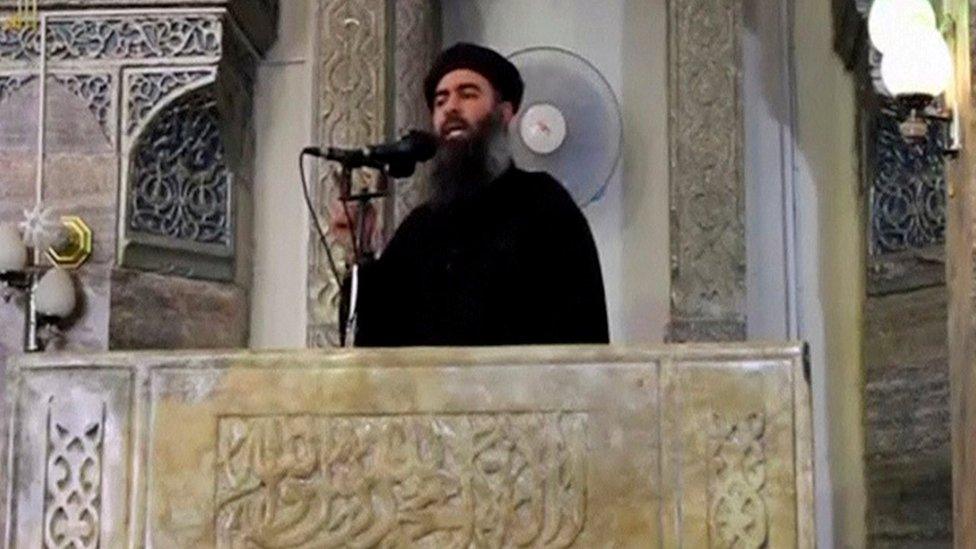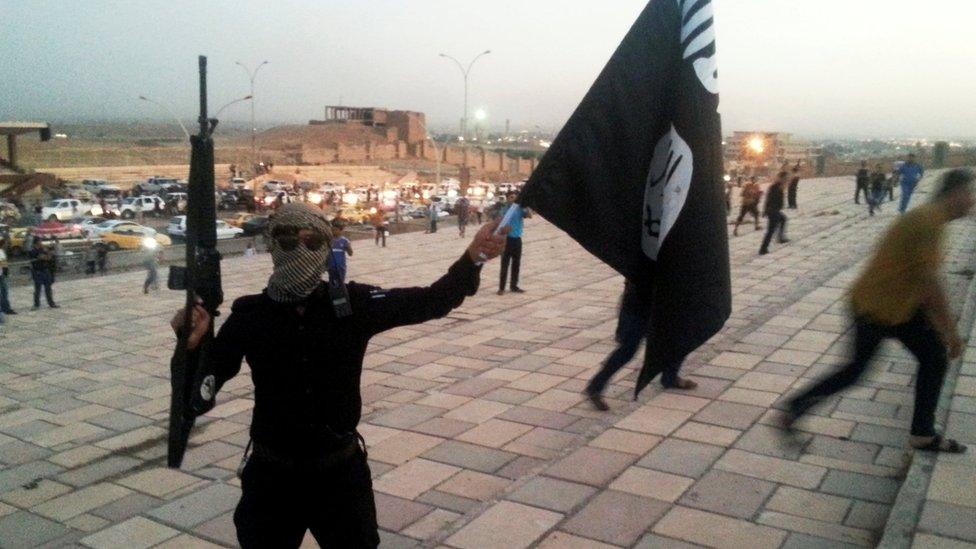Who is Islamic State leader Abu Bakr al-Baghdadi?
- Published

Baghdadi emerged from the shadows, appearing in Mosul in June 2014
Ibrahim Awwad Ibrahim al-Badri, otherwise known as Abu Bakr al-Baghdadi, was born in 1971 in Samarra, Iraq, to a lower-middle class Sunni family.
His family was known for its piety and his tribe claimed descent from the Prophet Muhammad.
As a youth, Baghdadi had a passion for Koranic recitation and was meticulous in his observance of religious law.
His family nicknamed him "the Believer, external" because he would chastise his relatives for failing to live up to his stringent standards.
Baghdadi pursued his religious interests at university. He obtained a bachelor's degree in Islamic studies from the University of Baghdad in 1996, and a Master's and PhD in Koranic studies from Iraq's Saddam University for Islamic Studies in 1999 and 2007 respectively.
Until 2004, Baghdadi spent his graduate school years living in the Tobchi neighbourhood of Baghdad with his two wives and six children.
He taught Koranic recitation to neighbourhood children at the local mosque, where he was also the star of its football club.
During Baghdadi's time in graduate school, his uncle persuaded him to join the Muslim Brotherhood.
Baghdadi quickly gravitated towards the few violent ultra-conservatives in the Islamist movement and by 2000, under their tutelage, had embraced Salafist jihadism.
Activist to insurgent
Within months of the 2003 US-led invasion of Iraq, Baghdadi helped found the insurgent group Jaysh Ahl al-Sunnah wa al-Jamaah (Army of the People of the Sunnah and Communal Solidarity).
In February 2004, US forces arrested Baghdadi in Falluja and sent him to a detention facility at Camp Bucca, where he remained for 10 months.
While in detention, Baghdadi devoted himself to religious matters, leading prayers, preaching Friday sermons, and conducting classes for prisoners.

The US held Baghdadi at a detention centre in Iraq for 10 months
According to a fellow inmate, Baghdadi was taciturn but had a knack for moving between the rival factions at the facility, where former Saddam loyalists and jihadists mingled.
Baghdadi formed alliances with many of them and stayed in touch when he was freed in December 2004.
After his release, Baghdadi contacted a spokesman for al-Qaeda in Iraq (AQI), a local al-Qaeda affiliate run by the Jordanian Abu Musab al-Zarqawi.
Impressed with Baghdadi's religious scholarship, the spokesman convinced Baghdadi to go to Damascus, where he was to ensure AQI's propaganda adhered to the principles of ultra-conservative Islam.
Zarqawi was killed in June 2006 by a US air strike and was succeeded by an Egyptian, Abu Ayyub al-Masri.
That October, Masri dissolved AQI and founded the Islamic State in Iraq (ISI). The group continued to privately pledge allegiance to al-Qaeda.
The new emir
Because of Baghdadi's religious credentials and his ability to bridge the divide between the foreigners who founded ISI and the local Iraqis who later joined the group, Baghdadi steadily rose through the ranks.
He was appointed supervisor of the Sharia Committee and named to the 11-member Shura Council that advised ISI's emir, Abu Omar al-Baghdadi.

Baghdadi exploited the chaos in Syria to gain a foothold there for Islamic State
Baghdadi was later appointed to ISI's Co-ordination Committee, which oversaw communication with the group's commanders in Iraq.
After the deaths of ISI's founder and its emir in April 2010, the Shura Council chose Abu Bakr al-Baghdadi to be the new emir.
Baghdadi set about rebuilding the organisation, which had been decimated by US special operations forces.
Hoping to capitalise on growing unrest in Syria in 2011, Baghdadi ordered one of his Syrian operatives to establish a secret branch of ISI in the country, later known as al-Nusra Front.
Advent of Isis
Baghdadi soon fell out with the leader of al-Nusra, Abu Mohammed al-Julani, who wanted to collaborate with the mainstream Sunni rebels fighting Syria's President Bashar al-Assad.
But Baghdadi wanted to establish his own state through brute force before going after Assad.
In the spring of 2013, Baghdadi announced that al-Nusra was part of ISI, which he renamed "Islamic State in Iraq and al-Sham/the Levant" (Isis/Isil).

So-called Islamic State was formed in defiance of the al-Qaeda leadership
When al-Qaeda's leader Ayman al-Zawahiri ordered Baghdadi to grant al-Nusra its independence, Baghdadi refused. In February 2014, Zawahiri expelled Isis from al-Qaeda.
Isis responded by fighting al-Nusra and consolidating its hold on eastern Syria, where Baghdadi imposed harsh religious laws.
Its stronghold secure, Baghdadi ordered his men to expand into western Iraq.
The caliph
In June 2014, Isis captured Iraqi's second largest city, Mosul, and soon after, the group's spokesman proclaimed the return of the caliphate, renaming Isis "Islamic State".
Days later, Baghdadi delivered a Friday sermon in Mosul and declared himself caliph.
The media has wrongly reported Baghdadi's demise several times.
But if he dies, the organisation will lose a skilled mediator, a ruthless politician, a religious scholar, and a man of noble lineage - an unusual combination for the leader of a global militant organisation, much less a proto-state.
William McCants is the author of The ISIS Apocalypse: The History, Strategy, and Doomsday Vision of the Islamic State. He directs the Project on US Relations with the Islamic World at the Brookings Institution and teaches at Johns Hopkins University. Follow him on Twitter, external.